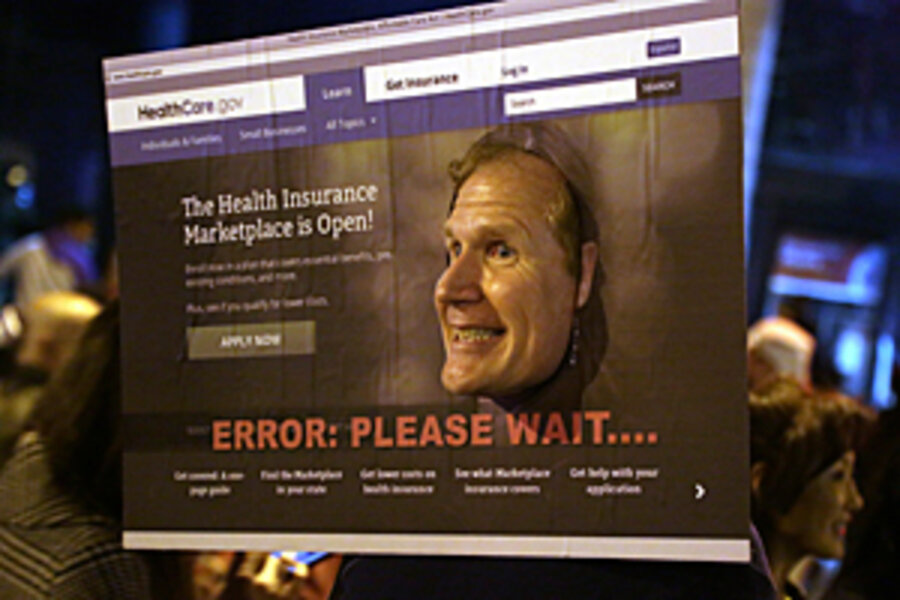Obamacare and you: Do I have to have Obamacare?
Obamacare will cause big changes in the way many Americans get health care. That’s been the subject of a lot of news in recent weeks. But it can be hard for average people to figure how this complicated new law affects their particular circumstances. Its website, HealthCare.gov, isn’t working well, and Washington seems preoccupied with political wrangling over the program.
We’re trying to help clear up this confusion by explaining in simple language important aspects of Obamacare, which is also known as the Affordable Care Act. We’ve already discussed when Obamacare starts and upcoming dates on its calendar. Now we’ll address a core issue: Who has to have Obamacare? How many people does it expect to enroll?
The bottom line: Only a small percentage of the US population needs to sign up for Obamacare health plans.
It’s true that the Affordable Care Act requires all Americans to have health insurance. This “individual mandate” represents a big change in US law. But the ACA does not require all Americans to buy their health insurance through its new state exchanges, which are virtual stores for individual health plans. If your brother-in-law or third cousin or company receptionist told you that, they’re wrong.
To understand who has to have Obamacare, let’s back up and look at where most Americans get their health coverage now.
About 55 percent of the people in the nation are covered by an insurance policy that they or someone in their family get through a job, according to the Census Bureau. For them, not much will change due to direct Obamacare effects. This is likely to be especially true if the employer is a big company.
The Affordable Care Act does include some new requirements for job-based plans. Children can stay on their parents’ insurance up to age 26, for example. And beginning in 2015, companies with more than 50 workers will have to offer health insurance to employees, or pay a fine.
If you get insurance from your job, it’s OK for you to shop in Obamacare’s exchanges. But you probably won’t find a better deal than your employer offers. In part, that’s because you won’t be eligible for federal subsidies to defray the cost of the exchange’s insurance wares.
Another one-third of Americans currently have their health-care costs covered by the US government. They are seniors on Medicare, lower-income Americans on Medicaid, or members of the military on the Pentagon’sTricare program.
Again, not much will change here – with one exception.
Medicare recipients won’t have to make any choices about their insurance coverage due to Obamacare. That’s also true for Tricare enrollees. But Obamacare expands the Medicaid program to include more lower-income US residents. That is one of the main ways the law attempts to cover people who are currently uninsured.
You may now qualify for Medicaid if you are a single person earning less than about $16,000 a year. If you have a spouse, children, or other dependents, the income eligibility level will be somewhat higher.
There’s a catch, though. The US Supreme Court ruled that states don’t have to expand Medicaid under Obamacare if they don’t want to. Right now, 29 states are moving toward expansion, according to the consulting firm The Advisory Board. You’ll need to check to see if your state is among them.
Now we come to Americans who buy their health insurance themselves on the open market. This is about 5 percent of the population, or 15 million people. Typically, these people work for small firms that don’t offer insurance, or they work for themselves, or they don’t work but don’t qualify for Medicare or Medicaid.
These folks can still shop for policies on the open market if they want. But they will also be able to buy insurance through the Obamacare state exchanges. (At least, they will if and when the federal doorway to these exchanges, HealthCare.gov, gets its act together.)
Obamacare’s intent is that those who buy individual policies will find better deals on the exchanges. Companies will compete for business in the marketplaces, goes the theory. Then there are the subsidies. The federal government will help pay for health insurance for individuals with annual income up to $46,000. The figure is substantially higher for families.
Last, there are those Americans who are currently uninsured. That’s about 15 percent of the population, or 48 million people. They’ll have to get some kind of health coverage for 2014, or pay a penalty.
The Obamacare exchanges are meant to appeal to them. The federal subsidies will help those who could not afford health coverage to buy it, goes the thinking. The penalties will spur those who just hadn’t bothered to finally purchase policies.
If things go as planned (they haven’t so far), in 2014 7 million Americans will buy private insurance through the health-care exchanges established by Obamacare, according to the Congressional Budget Office. Another 9 million will enroll in Medicaid due to its expansion.
That’s a total of 16 million people who might be said to “have Obamacare” during its first year – or about 5 percent of the US population. The CBO estimates that 44 million people will still remain uninsured in 2014.






